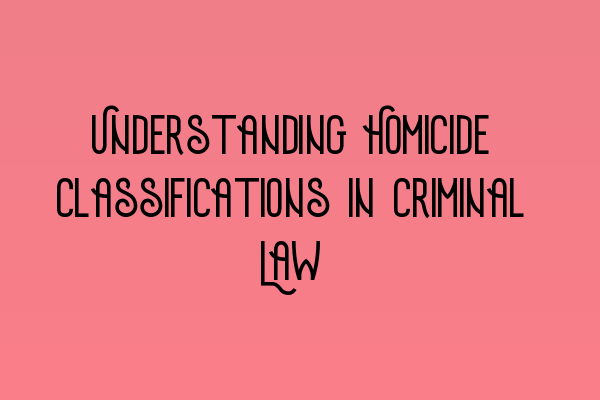Understanding Homicide Classifications in Criminal Law
When it comes to the study of criminal law, one area that often captures the attention of aspiring solicitors and legal professionals is the classification of homicide offenses. Homicide refers to the unlawful killing of another person, and the classification of such offenses helps to differentiate their severity and legal ramifications.
What is Homicide?
Homicide is the broader term that encompasses all instances of unlawful killing. It is important to note that not all homicides are considered criminal offenses, as there are instances where the act is justified or excused under the law. However, for the purpose of this discussion, we will focus on criminal homicides.
Classification of Homicide Offenses
In criminal law, homicide offenses are classified into different categories based on the level of intent, mental state, and circumstances surrounding the act. The main classifications of homicide offenses include:
- Murder
- Manslaughter
- Infanticide
- Attempted Homicide
Murder
Murder is the most serious form of homicide. It involves the intentional killing of another person with malice aforethought, which means the offender had the intent to cause death or serious bodily harm. Murder is further divided into degrees, such as first-degree murder and second-degree murder, each carrying different levels of intent and punishment.
The concept of murder and its degrees varies from jurisdiction to jurisdiction, so it is important to understand the specific laws and definitions applicable to the relevant jurisdiction.
Manslaughter
Manslaughter, on the other hand, refers to the unlawful killing of another person without malice aforethought. Unlike murder, manslaughter typically involves a lesser level of intent or the absence of premeditation. It can be further classified into voluntary manslaughter and involuntary manslaughter, each with its own elements and legal interpretations.
Voluntary manslaughter usually arises in instances where there is a sudden heat of passion or provocation that results in the unlawful killing. Involuntary manslaughter, on the other hand, involves unintentional killings caused by negligence, recklessness, or a failure to fulfill a duty of care.
Infanticide
Infanticide is a unique classification of homicide that specifically applies to the killing of a newborn baby by its mother during a period when her mind is disturbed as a result of childbirth. Infanticide laws aim to provide some leniency in cases where the mother’s mental state is affected, recognizing the complex physical and emotional factors involved.
Attempted Homicide
Attempted homicide occurs when a person takes substantial steps towards causing the death of another person, but the act does not result in death. It is important to note that even the mere attempt to commit homicide is considered a serious offense and carries significant legal consequences.
Conclusion
Understanding the classifications of homicide in criminal law is crucial for those pursuing a career in legal practice. It provides a foundation for analyzing and navigating complex cases involving unlawful killings. By familiarizing oneself with the various elements and definitions of murder, manslaughter, infanticide, and attempted homicide, aspiring solicitors can better serve their clients and contribute to the administration of justice.
For more information on criminal law and practice, as well as preparation for the SQE exams, feel free to explore the following related articles:
